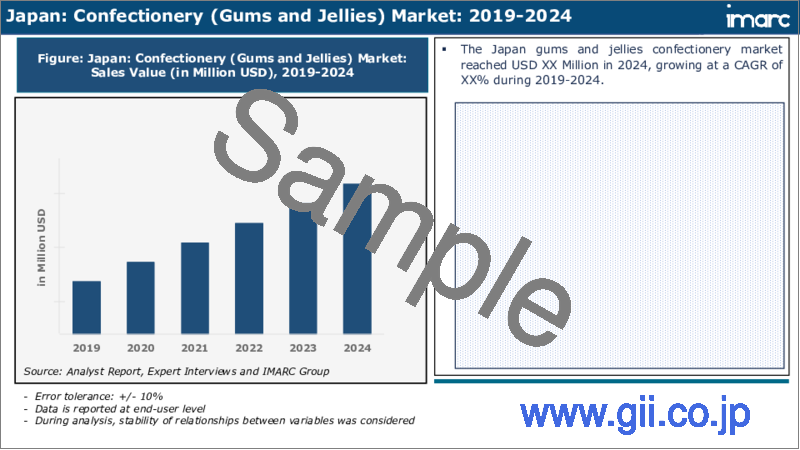|
|
市場調査レポート
商品コード
1729291
日本の菓子類市場レポート:製品タイプ、年齢層、価格帯、流通チャネル、地域別、2025年~2033年Japan Confectionery Market Report by Product Type, Age Group, Price Point, Distribution Channel, and Region 2025-2033 |
||||||
カスタマイズ可能
|
|||||||
| 日本の菓子類市場レポート:製品タイプ、年齢層、価格帯、流通チャネル、地域別、2025年~2033年 |
|
出版日: 2025年05月01日
発行: IMARC
ページ情報: 英文 118 Pages
納期: 5~7営業日
|
全表示
- 概要
- 目次
日本の菓子類の市場規模は2024年に287億米ドルに達しました。今後、IMARC Groupは、市場は2033年までに441億米ドルに達し、2025年から2033年にかけて4.9%の成長率(CAGR)を示すと予測しています。菓子類企業がより多くの消費者にリーチできるようになったeコマースプラットフォームの成長が、主に市場を牽引しています。
本レポートで扱う主な質問
- 日本の菓子類市場はこれまでどのように推移し、今後どのように推移するのか?
- COVID-19が日本の菓子類市場に与えた影響は?
- 日本の菓子類市場の製品タイプ別区分は?
- 日本の菓子類市場の年齢層別区分は?
- 日本の菓子類市場の価格帯別区分は?
- 日本の菓子類市場の流通チャネル別区分は?
- 日本の菓子類市場のバリューチェーンにおける様々なステージとは?
- 日本の菓子類の主な促進要因と課題は?
- 日本の菓子類市場の構造と主要プレーヤーは?
- 日本の菓子類市場における競合の程度は?
- 日本の菓子類市場の規模は?
目次
第1章 序文
第2章 調査範囲と調査手法
- 調査の目的
- ステークホルダー
- データソース
- 市場推定
- 調査手法
第3章 エグゼクティブサマリー
第4章 日本の菓子類市場:イントロダクション
- 概要
- 市場力学
- 業界動向
- 競合情報
第5章 日本の菓子類市場情勢
- 過去および現在の市場動向(2019~2024年)
- 市場予測(2025~2033年)
第6章 日本の菓子類市場:製品タイプ別の内訳
- キャンディー
- ミント
- ガムとゼリー
- チョコレート
- キャラメルとトフィー
- 薬用菓子類
- 高級ベーカリー製品
- その他
第7章 日本の菓子類市場:年齢層別の内訳
- 子供
- 成人
- 高齢者
第8章 日本の菓子類市場:価格帯別の内訳
- エコノミー
- ミッドレンジ
- ラグジュアリー
第9章 日本の菓子類市場:流通チャネル別の内訳
- スーパーマーケットとハイパーマーケット
- コンビニエンスストア
- 薬局・ドラッグストア
- オンラインストア
- その他
第10章 日本の菓子類市場:競合情勢
- 概要
- 市場構造
- 市場企業のポジショニング
- 主要成功戦略
- 競合ダッシュボード
- 企業評価象限
第11章 主要企業のプロファイル
第12章 日本の菓子類市場:業界分析
- 促進要因、抑制要因、機会
- ポーターのファイブフォース分析
- バリューチェーン分析
第13章 付録
Japan confectionery market size reached USD 28.7 Billion in 2024. Looking forward, IMARC Group expects the market to reach USD 44.1 Billion by 2033, exhibiting a growth rate (CAGR) of 4.9% during 2025-2033. The increasing growth of e-commerce platforms that have allowed confectionery companies to reach a broader audience is primarily driving the market.
Confectionery is a delightful and diverse category of food that encompasses a wide array of sweet treats. From colorful candies to decadent chocolates, confectionery has a special place in hearts and taste buds. These sugary creations have been enjoyed by people of all ages and cultures for centuries, bringing joy and satisfaction with every bite. One of the most beloved aspects of confectionery is its versatility. Confectionery isn't just about taste; it's a form of artistry, with skilled artisans crafting intricate designs and flavors that captivate the senses. It also plays a significant role in celebrations and traditions. It's a symbol of happiness, shared on birthdays, holidays, and special occasions. Beyond its sweetness, confectionery often brings people together, fostering connections and creating lasting memories. In conclusion, confectionery is a delightful world of sweetness, creativity, and tradition. It's a reminder that life's pleasures can be found in the simplest and sweetest of indulgences.
Japan Confectionery Market Trends:
The confectionery market in Japan, driven by a multitude of factors, has experienced consistent growth in recent years. Firstly, consumers' increasing disposable incomes have played a pivotal role in boosting demand for confectionery products. As people have more money to spend, they are more inclined to indulge in sweets and treats. Moreover, the changing lifestyles and hectic routines of modern society have led to a surge in demand for convenient, on-the-go snack options, which often include confectionery items. Furthermore, the evolving preferences of consumers towards healthier and natural ingredients have driven innovation within the confectionery market. Manufacturers have responded by introducing products with reduced sugar content, organic ingredients, and clean labels to meet the demand for healthier options. Additionally, the regional reach of confectionery brands, fueled by e-commerce, has expanded their market presence, leading to increased sales. In conclusion, the Japan confectionery market growth is expected to be driven by rising incomes, changing consumer lifestyles, health-conscious choices, and market expansion.
Japan Confectionery Market Segmentation:
Product Type Insights:
- Hard-Boiled Sweets
- Mints
- Gums and Jellies
- Chocolate
- Caramels and Toffees
- Medicated Confectionery
- Fine Bakery Wares
- Others
Age Group Insights:
- Children
- Adult
- Geriatric
Price Point Insights:
- Economy
- Mid-Range
- Luxury
Distribution Channel Insights:
- Supermarkets and Hypermarkets
- Convenience Stores
- Pharmaceutical and Drug Stores
- Online Stores
- Others
Competitive Landscape:
The market research report has also provided a comprehensive analysis of the competitive landscape. Competitive analysis such as market structure, key player positioning, top winning strategies, competitive dashboard, and company evaluation quadrant has been covered in the report. Also, detailed profiles of all major companies have been provided. The companies in the market are adopting various strategic initiatives including new product launches and business alliances to gain a significant Japan confectionery market share.
Key Questions Answered in This Report:
- How has the Japan confectionery market performed so far and how will it perform in the coming years?
- What has been the impact of COVID-19 on the Japan confectionery market?
- What is the breakup of the Japan confectionery market on the basis of product type?
- What is the breakup of the Japan confectionery market on the basis of age group?
- What is the breakup of the Japan confectionery market on the basis of price point?
- What is the breakup of the Japan confectionery market on the basis of distribution channel?
- What are the various stages in the value chain of the Japan confectionery market?
- What are the key driving factors and challenges in the Japan confectionery?
- What is the structure of the Japan confectionery market and who are the key players?
- What is the degree of competition in the Japan confectionery market?
- How big is the confectionery market in Japan?
Table of Contents
1 Preface
2 Scope and Methodology
- 2.1 Objectives of the Study
- 2.2 Stakeholders
- 2.3 Data Sources
- 2.3.1 Primary Sources
- 2.3.2 Secondary Sources
- 2.4 Market Estimation
- 2.4.1 Bottom-Up Approach
- 2.4.2 Top-Down Approach
- 2.5 Forecasting Methodology
3 Executive Summary
4 Japan Confectionery Market - Introduction
- 4.1 Overview
- 4.2 Market Dynamics
- 4.3 Industry Trends
- 4.4 Competitive Intelligence
5 Japan Confectionery Market Landscape
- 5.1 Historical and Current Market Trends (2019-2024)
- 5.2 Market Forecast (2025-2033)
6 Japan Confectionery Market - Breakup by Product Type
- 6.1 Hard-Boiled Sweets
- 6.1.1 Overview
- 6.1.2 Historical and Current Market Trends (2019-2024)
- 6.1.3 Market Forecast (2025-2033)
- 6.2 Mints
- 6.2.1 Overview
- 6.2.2 Historical and Current Market Trends (2019-2024)
- 6.2.3 Market Forecast (2025-2033)
- 6.3 Gums and Jellies
- 6.3.1 Overview
- 6.3.2 Historical and Current Market Trends (2019-2024)
- 6.3.3 Market Forecast (2025-2033)
- 6.4 Chocolate
- 6.4.1 Overview
- 6.4.2 Historical and Current Market Trends (2019-2024)
- 6.4.3 Market Forecast (2025-2033)
- 6.5 Caramels and Toffees
- 6.5.1 Overview
- 6.5.2 Historical and Current Market Trends (2019-2024)
- 6.5.3 Market Forecast (2025-2033)
- 6.6 Medicated Confectionery
- 6.6.1 Overview
- 6.6.2 Historical and Current Market Trends (2019-2024)
- 6.6.3 Market Forecast (2025-2033)
- 6.7 Fine Bakery Wares
- 6.7.1 Overview
- 6.7.2 Historical and Current Market Trends (2019-2024)
- 6.7.3 Market Forecast (2025-2033)
- 6.8 Others
- 6.8.1 Historical and Current Market Trends (2019-2024)
- 6.8.2 Market Forecast (2025-2033)
7 Japan Confectionery Market - Breakup by Age Group
- 7.1 Children
- 7.1.1 Overview
- 7.1.2 Historical and Current Market Trends (2019-2024)
- 7.1.3 Market Forecast (2025-2033)
- 7.2 Adult
- 7.2.1 Overview
- 7.2.2 Historical and Current Market Trends (2019-2024)
- 7.2.3 Market Forecast (2025-2033)
- 7.3 Geriatric
- 7.3.1 Overview
- 7.3.2 Historical and Current Market Trends (2019-2024)
- 7.3.3 Market Forecast (2025-2033)
8 Japan Confectionery Market - Breakup by Price Point
- 8.1 Economy
- 8.1.1 Overview
- 8.1.2 Historical and Current Market Trends (2019-2024)
- 8.1.3 Market Forecast (2025-2033)
- 8.2 Mid-Range
- 8.2.1 Overview
- 8.2.2 Historical and Current Market Trends (2019-2024)
- 8.2.3 Market Forecast (2025-2033)
- 8.3 Luxury
- 8.3.1 Overview
- 8.3.2 Historical and Current Market Trends (2019-2024)
- 8.3.3 Market Forecast (2025-2033)
9 Japan Confectionery Market - Breakup by Distribution Channel
- 9.1 Supermarkets and Hypermarkets
- 9.1.1 Overview
- 9.1.2 Historical and Current Market Trends (2019-2024)
- 9.1.3 Market Forecast (2025-2033)
- 9.2 Convenience Stores
- 9.2.1 Overview
- 9.2.2 Historical and Current Market Trends (2019-2024)
- 9.2.3 Market Forecast (2025-2033)
- 9.3 Pharmaceutical and Drug Stores
- 9.3.1 Overview
- 9.3.2 Historical and Current Market Trends (2019-2024)
- 9.3.3 Market Forecast (2025-2033)
- 9.4 Online Stores
- 9.4.1 Overview
- 9.4.2 Historical and Current Market Trends (2019-2024)
- 9.4.3 Market Forecast (2025-2033)
- 9.5 Others
- 9.5.1 Historical and Current Market Trends (2019-2024)
- 9.5.2 Market Forecast (2025-2033)
10 Japan Confectionery Market - Competitive Landscape
- 10.1 Overview
- 10.2 Market Structure
- 10.3 Market Player Positioning
- 10.4 Top Winning Strategies
- 10.5 Competitive Dashboard
- 10.6 Company Evaluation Quadrant
11 Profiles of Key Players
- 11.1 Company A
- 11.1.1 Business Overview
- 11.1.2 Product Portfolio
- 11.1.3 Business Strategies
- 11.1.4 SWOT Analysis
- 11.1.5 Major News and Events
- 11.2 Company B
- 11.2.1 Business Overview
- 11.2.2 Product Portfolio
- 11.2.3 Business Strategies
- 11.2.4 SWOT Analysis
- 11.2.5 Major News and Events
- 11.3 Company C
- 11.3.1 Business Overview
- 11.3.2 Product Portfolio
- 11.3.3 Business Strategies
- 11.3.4 SWOT Analysis
- 11.3.5 Major News and Events
- 11.4 Company D
- 11.4.1 Business Overview
- 11.4.2 Product Portfolio
- 11.4.3 Business Strategies
- 11.4.4 SWOT Analysis
- 11.4.5 Major News and Events
- 11.5 Company E
- 11.5.1 Business Overview
- 11.5.2 Product Portfolio
- 11.5.3 Business Strategies
- 11.5.4 SWOT Analysis
- 11.5.5 Major News and Events
12 Japan Confectionery Market - Industry Analysis
- 12.1 Drivers, Restraints and Opportunities
- 12.1.1 Overview
- 12.1.2 Drivers
- 12.1.3 Restraints
- 12.1.4 Opportunities
- 12.2 Porters Five Forces Analysis
- 12.2.1 Overview
- 12.2.2 Bargaining Power of Buyers
- 12.2.3 Bargaining Power of Suppliers
- 12.2.4 Degree of Competition
- 12.2.5 Threat of New Entrants
- 12.2.6 Threat of Substitutes
- 12.3 Value Chain Analysis





